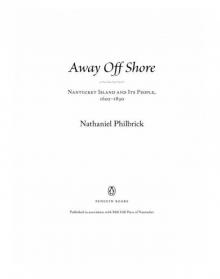- Home
- Nathaniel Philbrick
Away Off Shore: Nantucket Island and Its People, 1602-1890
Away Off Shore: Nantucket Island and Its People, 1602-1890 Read online
Table of Contents
PENGUIN BOOKS
Title Page
Copyright Page
Dedication
Preface
CHAPTER 1 - An Island and Its Altar
CHAPTER 2 - Native Origins: Maushop, Roqua, Wonoma, and Autopscot
CHAPTER 3 - Thomas Macy’s Great Escape
CHAPTER 4 - Tristram Coffin, Country Squire
CHAPTER 5 - “An Island Full of Indians”: King Philip, John Gibbs, and Peter Folger
CHAPTER 6 - Gardner versus Coffin: The Revolt
CHAPTER 7 - The Whaling Legacy of Ichabod Paddock
CHAPTER 8 - Mary Starbuck, High Priestess of the Company Store
CHAPTER 9 - Richard Macy, the Master Builder
CHAPTER 10 - Of God, Indians, and Getting By: The Hireling, Timothy White
CHAPTER 11 - Peleg Folger, the Poet Whaleman
CHAPTER 12 - Kezia Coffin’s Revolutionary Rise and Fall
CHAPTER 13 - The “Removals”: From Jethro Coffin to William Rotch
CHAPTER 14 - A “Nest of Love” No Longer: William Coffin and the Bank, Commons, ...
CHAPTER 15 - The Golden Boy and the Dark Man: Obed Starbuck and George Pollard
CHAPTER 16 - Absalom Boston and Abram Quary: “Of Color” on the Grey Lady
CHAPTER 17 - Maria Mitchell, the Provincial Cosmopolitan
CHAPTER 18 - F. C. Sanford, the Mythmaker
Epilogue
Notes
Acknowledgements
Index
PENGUIN BOOKS
AWAY OFF SHORE
Nathaniel Philbrick is the author of the New York Times bestsellers In the Heart of the Sea, which won the National Book Award; Sea of Glory: America’s Voyage of Discovery, the U.S. Exploring Expedition, winner of the Theodore and Franklin D. Roosevelt Naval History Prize; Mayflower, a finalist for the Pulitzer Prize; and The Last Stand: Custer, Sitting Bull, and the Battle of the Little Bighorn. He has lived on Nantucket Island since 1986.
PENGUIN BOOKS
Published by the Penguin Group
Penguin Group (USA) Inc., 375 Hudson Street, New York, New York 10014, U.S.A.
Penguin Group (Canada), 90 Eglinton Avenue East, Suite 700, Toronto,
Ontario, Canada M4P 2Y3 (a division of Pearson Penguin Canada Inc.)
Penguin Books Ltd, 80 Strand, London WC2R 0RL, England
Penguin Ireland, 25 St Stephen’s Green, Dublin 2, Ireland (a division of Penguin Books Ltd)
Penguin Group (Australia), 250 Camberwell Road, Camberwell,
Victoria 3124, Australia (a division of Pearson Australia Group Pty Ltd)
Penguin Books India Pvt Ltd, 11 Community Centre,
Panchsheel Park, New Delhi–110 017, India
Penguin Group (NZ), 67 Apollo Drive, Rosedale, Auckland 0632,
New Zealand (a division of Pearson New Zealand Ltd)
Penguin Books (South Africa) (Pty) Ltd, 24 Sturdee Avenue,
Rosebank, Johannesburg 2196, South Africa
Penguin Books Ltd, Registered Offices:
80 Strand, London WC2R 0RL, England
First published in the United States of America by Mill Hill Press 1994
This edition with a new preface published in Penguin Books 2011
Copyright © Nathaniel Philbrick, 1994, 2011 All rights reserved
LIBRARY OF CONGRESS CATALOGING IN PUBLICATION DATA
Philbrick, Nathaniel.
Away off shore : Nantucket Island and its people, 1602–1890 / Nathaniel Philbrick.
p. cm.
“First published in the United States of America by Mill Hill Press, 1994”—T.p. verso.
Includes bibliographical references and index.
eISBN : 978-1-101-52854-9
1. Nantucket Island (Mass.)—History. 2. Nantucket Island (Mass.)—Biography. I. Title.
F72.N2P47 2011
974.4'97—dc22 2010053110
The scanning, uploading and distribution of this book via the Internet or via any other means without the permission of the publisher is illegal and punishable by law. Please purchase only authorized electronic editions, and do not participate in or encourage electronic piracy of copyrighted materials. Your support of the author’s rights is appreciated.
http://us.penguingroup.com
For Melissa
Preface to the Penguin Edition
IN SEPTEMBER OF 1986, I moved to Nantucket with my wife Melissa and our two children. It was Melissa’s job as an attorney that brought us to the island, a sandy crescent almost thirty miles out to sea about which I knew almost nothing—except, of course, for what I’d read in Herman Melville’s Moby-Dick. Not surprisingly, in retrospect, I was immediately taken with Nantucket’s whaling past. At that time I was a freelance sailing journalist, but with each passing year I delved ever deeper into the island’s history, eventually publishing a handful of articles in academic journals such as the New England Quarterly. Then, in the spring of 1992, I got my first big break.
In those days any Nantucketer with literary aspirations looked for guidance from Mimi Beman, proprietress of Mitchell’s Book Corner on Main Street. As it so happened, Mimi had been contacted by Albert “Bud” Egan, Jr., owner of the Marine Home Center, a highly successful lumberyard and home furnishings business on Lower Orange Street. Bud had a long-standing interest in the island’s history, which he attributed to his mother who’d come from one of Nantucket’s founding families, the Coffins. Just a few years before, Bud had started the Mill Hill Press and was now in search of an author to write a history of the island through the end of whaling in the late nineteenth century. Based on the articles I’d shown her, Mimi recommended me.
I’ll never forget my first meeting with Bud in his second-floor office overlooking the sheds of the lumberyard and beyond that the marshy convolutions of Nantucket Harbor. Bud was a no nonsense kind of guy. I should submit an outline and sample preface to Mimi, who was acting as his informal consultant, and we’d take it from there. It was my first commission to write history.
Over the course of the next few weeks, I found myself writing and rewriting that preface. I didn’t know it at the time, but I was establishing what was to become my method for starting a book. By working my way through draft after draft of the opening overview, I slowly came to understand what it was I wanted to say. I also began to find my own voice as an historian. Most important, I was able to move from a disparate pile of notes and ideas to a firm structure for the book. I would devote each chapter to a specific character whose story would move the overall history of the island forward to the next character until I had finally made my way to the end of Nantucket’s whaling era.
Mimi gave me the green light, and in the fall of 1992, at the age of thirty-six, I embarked on the path I’ve been following ever since. By going directly to the sources—whether they be in the archives or out there in the landscape—I hoped to hunt out the stories and the characters that brought the past to life.
First I went to the Nantucket Town Building, an undistinguished brick edifice containing a warren of little rooms stuffed to overflowing with records and documents, many of them dating back to the mid-seventeenth century. Then it was on to the Nantucket Historical Association. This was the pre-Internet era, so instead of calling up archives on my laptop at home, I spent weeks in their library, reading almost a century’s worth of island newspapers on microfilm. I was so new to it all that I didn’t fully appreciate at that time the extraordinary richness of the association’s collection: journals, logs, daybooks, and letters that revealed the history and culture of both an island and the i
ndustry that made it famous. It was in the archives of yet another island repository, the Nantucket Atheneum (which also happened to be the town’s public library), that I found my favorite artifact: the journal of Peleg Folger, a young whaleman in the middle of the eighteenth century with an eye for the telling detail and a wicked sense of humor.
Since my children, then seven and ten, could be counted on to return home from school every afternoon at precisely two thirty (and I was the one responsible for meeting them), I decided to enlist them in the enterprise. After school we’d all pile into the car and search out the places about which I’d been reading, places like the Hidden Forest in the eastern portion of the island, near where the Wampanoag leader King Philip seized the “praying Indian” John Gibbs, and Capaum Pond, the kettle hole to the west that had once been at the center of the first English settlement. What became known as “Daddy’s wild goose chases” often left us muddy and itchy with poison ivy, but these escapades proved immensely helpful when it came to understanding the importance of place to the past. On a tiny sea-swept island, geography matters, and I was lucky to have the past right there, under my feet.
By the end of December I was about a quarter of the way through a first draft. During a New Year’s Day visit to Lake Winnipesaukee, my good friend Peter Gow provided crucial input and encouragement and became the book’s editor. By Memorial Day weekend I’d finished a first draft, and with the help of Peter, my father (a retired English professor who doubled as our copy editor), and my mother-in-law (a retired librarian who created the index), I rethought, rewrote, and revised, another process I’ve followed in every book since. The manuscript was done by the fall of 1993 and published in the spring of 1994.
In the almost twenty years since, much has changed on the island. Sadly, Bud Egan and Mimi Beman have both passed away. However, Bud’s love of Nantucket history has been memorialized in the form of the Egan Maritime Institute, an organization that celebrates Nantucket’s seafaring heritage and continues to publish books through the Mill Hill Press, while the store Mimi turned into a Nantucket institution, Mitchell’s Book Corner, is still operating on Main Street. This book honors both Nantucket’s past and its future. With the reissuing of Away Off Shore as a Penguin paperback, it’s my hope that the book with which I found a calling will now find a new audience.
—Nathaniel Philbrick Nantucket, January 2011
Preface
“Nantucket! Take out your map and look at it. See what a real corner of the world it occupies: how it stands there, away off shore . . .”
—Herman Melville
IT IS A CURIOUS DESIGN: the arm of Cape Cod bent northward over the irregular shapes of Martha’s Vineyard and Nantucket Island. If the Vineyard hovers beside the Cape like a clinging child, Nantucket stands out defiantly to the east, straining to put even more distance between itself and the continent behind it. It is a curling crescent of sand that wants to be left alone.
Given the island’s place on the map, you might expect Nantucketers to be an independent bunch, and you would be right. After crossing Nantucket Sound more than 300 years ago, the first white settlers were not about to follow in the footsteps of the New Englanders they sailed all that distance to escape. Instead, they went their own way in a truly spectacular fashion. By 1775 this tiny island had become the foremost whaling port in the world, prompting the British statesman Edmund Burke to look to its inhabitants as the leaders of a new American breed: a “recent people . . . who are still, as it were, but in the gristle, and not yet hardened into the bone of manhood.”
Although the Nantucketers undoubtedly enjoyed Burke’s praise, they were reluctant to identify themselves with the colonies to their west. When America went to war, Nantucket wanted no part of it, steadfastly avoiding all involvement in the Revolution and even negotiating its own private peace treaty during the War of 1812. It is true that many of the Nantucketers were Quaker pacifists, but there were other motives influencing their determination to go it alone. Living on an island that already enjoyed world-wide recognition and respect, Nantucketers were not about to defer to another and (in their eyes) less esteemed country. As far as they were concerned, Nantucket was a commonwealth of its own. During a visit in 1847, the essayist and poet Ralph Waldo Emerson recognized “a strong national feeling” on the island and commented in his journal, “Nation of Nantucket makes its own war & peace.”
As a nation beside a nation, Nantucket was (and is) both a microcosm of America and an exception to the rule: a tightly knit community that took its special brand of provincialism all across the world, becoming, in the process, one of the most cosmopolitan places in America. On an island of paradoxes, the Quaker whalemen were perhaps the most paradoxical. At once pacifist whalehunters, plain-dressed millionaires, abolitionist floggers of common seamen, and devoted family men who were never home, these “Quakers with a vengeance” embodied a truly mind-boggling array of contradictions.
But the whalemen are only part of the story. Since their husbands were often on the other side of the planet, the women of Nantucket developed their own kind of independence, enjoying freedoms and responsibilities that were literally centuries ahead of their time. Nantucket also had vital and well-defined African-American and Portuguese communities that contributed significantly to the island’s whaling prosperity. Before a horrifying plague decimated their population in 1763, Native Americans exerted a strong and lasting influence on the island, to be followed by yet another native culture in the nineteenth century when increasing numbers of Pacific islanders came to Nantucket on the decks of whaleships.
Ultimately, the history of Nantucket is as much about the interaction of different cultures as it is the story of what Obed Macy, the island’s first historian, described as “the peaceable settlement of a few enterprising families, and their slow progress in wealth and numbers.” Just as it has become increasingly difficult to insist that the West was actually “won” by the American cowboy, so is it time to recognize that the island was something more than a spawning ground for Quaker whalemen. If in the pages that follow many heroes of old are portrayed in a less than flattering light, I am by no means the first to claim that Nantucket’s past was hardly as “peaceable” as Obed Macy would have had us believe. In 1877 the Nantucketer Alexander Starbuck began his History of the American Whale Fishery with this statement: “If in the search for facts the historical idols of others have been shattered, it may be a source of satisfaction to them to learn that the writer has been equally iconoclastic with many that he too has reverenced.”
But the main aim of this book is not to discredit the mythic men of Nantucket’s heyday; instead, it is to bring to life the island’s history by focusing on the individual men and women—in all their flawed and fascinating glory—who helped to make Nantucket the whaling capital of the world. The dates referred to in the book’s subtitle (1602–1890) span two events: Bartholomew Gosnold’s first exploratory voyage to the Cape and islands and the death of Frederick C. Sanford, the man who not only lived through the final rise and fall of the Nantucket whale fishery but also helped to record (and romanticize) it for future generations. While the story of the island’s subsequent rise as a summer colony is an important one that needs to be told, it is beyond the scope of this work.
In an effort to make the Nantucketers of the seventeenth, eighteenth, and nineteenth centuries more accessible to a modern-day audience, the spelling and punctuation of quotations have been modernized. Although the text contains no footnotes, an extensive “Notes” section at the end of the book includes references as well as additional information and anecdotes.
In a book about Nantucketers, it is only appropriate, I think, that we begin with the island they all shared and helped to shape. No matter how much it has changed over the years, Nantucket still occupies the same place on the map. More than anything else, it is this place, “away off shore,” that has determined who the Nantucketer is.
Map of the Town of Nantucket, surveyed under H
enry F. Walling, Superintendent of State Maps, 1858.
Reproduced by permission of the Nantucket Historical Association.
William Mitchell’s map of Nantucket, 1838.
Reproduced by permission of the Nantucket Historical Association.
CHAPTER 1
An Island and Its Altar
IT IS A FARAWAY PLACE on a faraway island but well worth the trip: Altar Rock set atop Saul’s Hills, one of the highest points on Nantucket. Tradition has it that this glacierscored boulder was once sacred to the island’s Native Americans. Certainly it is hard to resist a religious sense of awe when standing beside it.
The view is breath-taking, particularly in fall when the gently rolling heathlands that stretch out in all directions (known locally as the Moors) are tinged with red and yellow. Although the hill is not high enough to enable one to see Nantucket in its entirety, Altar Rock is the best seat in the house when it comes to imagining how the island originally came into being. Between 22,000 and 16,000 years ago, a giant glacier stretching across what is now Nantucket Sound bulldozed Saul’s Hills into a rough approximation of their present form. This is where the icy shovel of the bulldozer stopped, dumping the boulder we see beside us.
As global warming (by no means a new phenomenon) caused the glacier to melt, water began to run to the south, leaving behind a relatively smooth terrain of lighter sands and gravel known as an outwash plain. This is why the beach sand on the southern shore of the island is so much finer than that to the north, prompting one old-timer to observe, “I never saw a stone along the [south] shore bigger than a man’s head.” Fifteen thousand years ago, however, what is now a beach was a long way from the ocean; instead of being an island, Nantucket was a low range of hills more than forty miles inland.

 Bunker Hill: A City, a Siege, a Revolution
Bunker Hill: A City, a Siege, a Revolution Why Read Moby-Dick?
Why Read Moby-Dick? Second Wind: A Nantucket Sailor's Odyssey
Second Wind: A Nantucket Sailor's Odyssey The Last Stand: Custer, Sitting Bull, and the Battle of the Little Bighorn
The Last Stand: Custer, Sitting Bull, and the Battle of the Little Bighorn In the Heart of the Sea: The Epic True Story That Inspired Moby-Dick
In the Heart of the Sea: The Epic True Story That Inspired Moby-Dick Away Off Shore: Nantucket Island and Its People, 1602-1890
Away Off Shore: Nantucket Island and Its People, 1602-1890 The Mayflower and the Pilgrims' New World
The Mayflower and the Pilgrims' New World The Last Stand: Custer, Sitting Bull and the Battle of the Little Big Horn
The Last Stand: Custer, Sitting Bull and the Battle of the Little Big Horn Second Wind
Second Wind Away Off Shore
Away Off Shore The Mayflower and the Pilgrims' New World*
The Mayflower and the Pilgrims' New World* Sea of Glory
Sea of Glory In the Heart of the Sea
In the Heart of the Sea The Last Stand
The Last Stand In the Hurricane's Eye
In the Hurricane's Eye